Latest posts by (see all)
- The Best Things to Do in Tulsa - June 26, 2020
- The Most Interesting Things to Do in Springfield Mo - June 15, 2020
- Best Things to Do in Salt Lake City - May 26, 2020
- 10 Best Websites for Playing Online Games - May 22, 2020
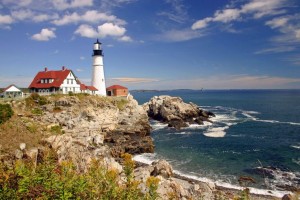 If you are looking for a place to relax with beautiful landscapes, intriguing history and friendly people, then visit New England in the USA. New England is located in the northeast of the United States and includes: Connecticut, Rhode Island, Massachusetts, New Hampshire, Vermont and Maine. New England is the birthplace of America that is filled with a rich history, cultural attractions, fascinating cities, picturesque villages, and adventures at every turn.
If you are looking for a place to relax with beautiful landscapes, intriguing history and friendly people, then visit New England in the USA. New England is located in the northeast of the United States and includes: Connecticut, Rhode Island, Massachusetts, New Hampshire, Vermont and Maine. New England is the birthplace of America that is filled with a rich history, cultural attractions, fascinating cities, picturesque villages, and adventures at every turn.
Autumn is an ideal time to visit this region, when the leaves on the trees turn from green into thousands of different shades of gold, red and orange. In winter, you can ski in the mountains and enjoy the evenings by the cozy fireplace at the hotel. In spring and summer New England is a place for hiking and cycling in the mountains and around lakes and visiting beautiful beaches.
Discover white sandy beaches and lighthouses, a bright fall leaf fall, expansive lakes, panoramic views of the mountains and port restaurants with delicious seafood soups, lobsters, and of course blueberry pies. In New England, you will find many different experiences, starting from a trip from Logan International Airport in Boston in just a few hours.
Contents
- Place to visit number 1: Copley Square
- Place to visit number 2: Skyscraper Prudential Tower
- Place to visit number 3: Salem Witch Museum
- Place to visit number 4: Christian Science complex
- Place to visit number 5: The Boston Symphony Hall
- Place to visit number 6: St. Johnsbury Athenaeum
- Place to visit number 7: George Perkins Marsh Boyhood Home
- Place to visit number 8: Smugglers’ Notch State Park
- Place to visit number 9: Church Street Marketplace
- Place to visit number 10: St. Joseph’s Cathedral
- Place to visit number 11: The Frog Bridge
- Place to visit number 12: Paul Revere House
- Video
Place to visit number 1: Copley Square
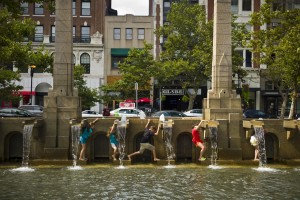 The area is known as the finish spot of the popular Boston marathon. Impressive buildings located around the square look perfectly in harmony with the greenery of the park. The buildings around the square are different in style and age but together they form an incredible architectural ensemble.
The area is known as the finish spot of the popular Boston marathon. Impressive buildings located around the square look perfectly in harmony with the greenery of the park. The buildings around the square are different in style and age but together they form an incredible architectural ensemble.
Located in New England, Boston Copley Square is a famous tourist destination due the following reasons:
- Copley Square is one of the most outstanding architectural monuments of the city named in honor of the native of Boston – John Singleton Copley, a famous painter and portraitist of the late 18th century. He became famous not only for his creativity, but also for donating a piece of land to the city.
- There are many popular boutiques, shops and salons to visit.
- There is the Boston Public Library, opened in 1895. Its building is made in the style of luxurious Italian palaces.
- On the south side of the square there is the Museum of Fine Arts, the second largest in the United States. With its appearance for many decades, not only Copley Square, but also Boston got the right to be considered the intellectual capital of the country in the twentieth century.
Interesting: On Copley Square you can see the famous 60-story skyscraper or Tower of Hancock, known to many in the frame of films.
Back
Place to visit number 2: Skyscraper Prudential Tower
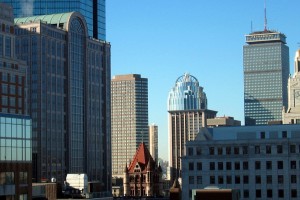 The height of Prudential Tower is 228 meters. It is the second largest skyscraper in Boston. However, if you add a spire to the height of the tower, it becomes the highest in the city – in this case the total height of the building will be equal to 276 meters.
The height of Prudential Tower is 228 meters. It is the second largest skyscraper in Boston. However, if you add a spire to the height of the tower, it becomes the highest in the city – in this case the total height of the building will be equal to 276 meters.
Skyscraper Prudential Tower was built in 1964, and it was opened in 1965. It consists of 52 floors.
The building contains about 4000 windows and almost half a million square meters of:
- office space,
- expensive shops
- and boutiques.
On the top floor there is a restaurant, and on the 50th floor there is a covered observation deck, which is considered the highest in New England. From it opens a magnificent panorama of sunny Boston. Certainly, this skyscraper deserves special attention of tourists and, being in Boston, it is necessary to visit this unique structure.
Interesting: Until the time when the John Hancock Tower was built, the skyscraper remained the tallest in the city.
Back
Place to visit number 3: Salem Witch Museum
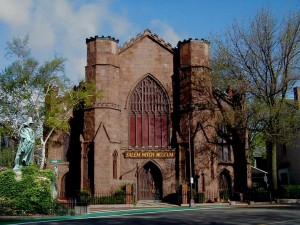 Once Salem was a small town, which was famous for the whole world by witch hunts. A visit to the Museum of Salem witches will allow you to return in 1962, plunge into that time and feel like a part of it. At the end of the 17th century, a trial was held in the city of Salem over five girls who were obsessed, shouted and
Once Salem was a small town, which was famous for the whole world by witch hunts. A visit to the Museum of Salem witches will allow you to return in 1962, plunge into that time and feel like a part of it. At the end of the 17th century, a trial was held in the city of Salem over five girls who were obsessed, shouted and
beat in cramps. The city began to hunt witches, which served as the basis for the opening of museums in the future.
In Salem, there are several museums:
- the world’s largest Witch Museum,
- the Witches’ Dungeon Museum
- and the Peabody Museum of Essex.
The Witch Museum contains about 500 original documents on trials of witches and horrific instruments of torture of that time. All this will help to plunge into the history: scenery, figures in full growth, symbols, attributes, lighting. The museum provides such a service as an on-line guide to the museum, where you will be told about stereotypes, various opinions about the interpretation of witchcraft, as well as about the witches themselves and about hunting for them.
Interesting: There are souvenir shops where you can buy cards, accessories, souvenirs, clothes (of course, in a peculiar style, but it is very useful for Halloween). In the bookshop you can also completely satisfy your curiosity about witches.
Back
Place to visit number 4: Christian Science complex
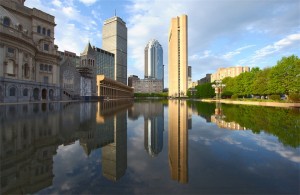 Among the monuments of architecture of Boston there is a huge number of churches. One of the most expressive and grandiose is the Christian Science complex. It is the headquarters of the Boston religious movement, which opposes the use of medicines.
Among the monuments of architecture of Boston there is a huge number of churches. One of the most expressive and grandiose is the Christian Science complex. It is the headquarters of the Boston religious movement, which opposes the use of medicines.
The story behind the appearance of the Christian Science complex is the following:
- The movement was founded in 1879 by Mary Baker Eddy who was sick with a serious illness that could not be cured by drugs or surgical intervention.
- After in 1866, Mary received another trauma and despaired of recovering, she turned to the Bible. Unexpectedly, for Mary herself and for all those around her, the disease receded. Recovering from a great amazement, she began to convince herself that illnesses are just the fruit of our imagination, and only in prayer one can recover.
- She developed so-called Christian science and began to preach in a specially constructed building.
Gradually the number of supporters of her theory began to grow, and today there are many parishioners.
Interesting: The complex of buildings includes the lavish building of the church, built in 1879, along which the swimming pool is located.
Back
Place to visit number 5: The Boston Symphony Hall
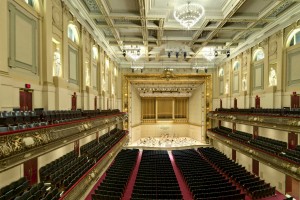 The Boston Symphony Orchestra is widely known not only in the States but throughout the world. In addition to being one of the oldest symphony orchestras in the US, it includes world-class stars. Since 1900 the orchestra is based in the Symphony Hall, which can accommodate 2600 spectators and has one of the best acoustic data in the world.
The Boston Symphony Orchestra is widely known not only in the States but throughout the world. In addition to being one of the oldest symphony orchestras in the US, it includes world-class stars. Since 1900 the orchestra is based in the Symphony Hall, which can accommodate 2600 spectators and has one of the best acoustic data in the world.
Things to know about the hall building:
- When the project of a new concert hall was created at the beginning of the 20th century, the image of the famous concert hall in Leipzig, unfortunately destroyed during the Second World War, was taken as a basis.
- The hall has the form of a rectangle, narrow enough and with high walls. The design of the scene is very unique – it is slightly inclined inwards, this is done to better focus the sound.
- Virtually all elements are made of bricks, steel and plaster, with the exception of the wooden floor of the stage.
- Decoration is rather restrained – everything is thought out very carefully so that no detail interferes with the purity of the sound, without muffling it and not redirecting it.
In the Symphony Hall there is one of the best concert organs in the world – it was installed by Donald Harrison in 1949. It has 4800 pipes installed in 62 rows. After the renewal in 2003, it produces almost the best sound in the world in its purity.
Interesting: In 1999, the Boston Symphony Hall was included in the list of National Monuments of History.
Back
Place to visit number 6: St. Johnsbury Athenaeum
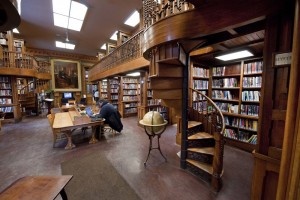 St. Johnsbury Athenaeum is a former library, which is an art gallery now. It is located in the city of St. John’s, Vermont. The reading room was founded in 1871. When the library opened, the collection consisted of 9,000 books selected by
St. Johnsbury Athenaeum is a former library, which is an art gallery now. It is located in the city of St. John’s, Vermont. The reading room was founded in 1871. When the library opened, the collection consisted of 9,000 books selected by
bibliographer William Poole. In 1873, a small art gallery was added. To date, “St. John’s” exhibited more than 100 works of art.
Here you will find:
- the original works of American artists,
- as well as copies of European masterpieces.
A significant part of the collection is represented by paintings by a group of American landscape painters of the mid-19th century, the so-called Hudson River School. The building itself was built in 1871 in the style of the Second French Empire.
Interesting: In 1996, the building was designated as the National Historical Monument of the United States and added to the National Register of Historic Places of the United States.
Back
Place to visit number 7: George Perkins Marsh Boyhood Home
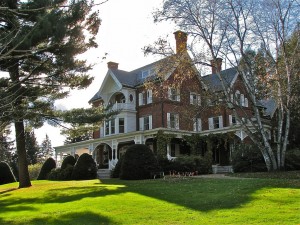 The George Perkins Marsh House of Childhood is also known as the Marsh-Billings house. The house of George Marsh is situated in Woodstock, Vermont.
The George Perkins Marsh House of Childhood is also known as the Marsh-Billings house. The house of George Marsh is situated in Woodstock, Vermont.
The Marsh-Billings House is popular due to the following reasons:
- George P. Marsh is a well-known American diplomat and philologist,
- He is considered the first ecologist and “protector of the wild nature” in America.
- The house was built in 1805 in the style of Queen Anne.
Now the house is located on the territory of the National Historical Park “Marsh-Billings-Rockefeller”. In 1967, the building was designated as the National Historical Monument of the United States.
Interesting: George Perkins Marsh Home has been added to the National Register of Historic Places of the United States.
Back
Place to visit number 8: Smugglers’ Notch State Park
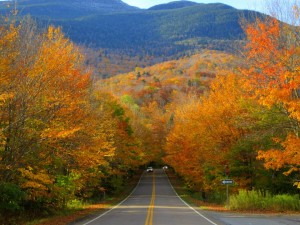 Smugglers’ Notch State Park is the park in the Green Mountains, located in the county of Lamoyl, Vermont, USA. This place got its name from Smugglers Notch. Such a gloomy name emerged after the British, bypassing the embargo imposed by the US president on trade between England and Canada through the territory of the United States, secretly carried goods through this gorge.
Smugglers’ Notch State Park is the park in the Green Mountains, located in the county of Lamoyl, Vermont, USA. This place got its name from Smugglers Notch. Such a gloomy name emerged after the British, bypassing the embargo imposed by the US president on trade between England and Canada through the territory of the United States, secretly carried goods through this gorge.
The embargo was imposed to protect America from involvement in the Napoleonic wars. For the inhabitants of the surrounding lands, the law became a big problem, and they continued illegal trade with Canada and transportation of English cargoes, and covered up these machinations with grazing on the paths of the gorge, which was permeated with caves and in those days almost deserted.
Now the Park is open all year round. But in winter, access to it is limited due to the emerging danger of avalanches from some peaks of the Green Mountains. There are many things to enjoy here, among the most favorite pastimes there are the following:
- Fishing: There are several walking routes in the park, most of which go to Mount Mansfield and the Sterling pond, which is famous for its excellent fishing.
- Camping: In the park there are more than twenty campsites.
Interesting: During the Dry Law, the same caves were used to store alcohol illegally imported from Canada.
Back
Place to visit number 9: Church Street Marketplace
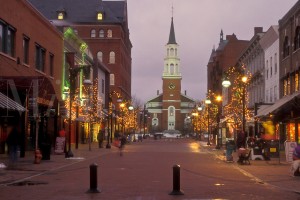 Church Street Marketplace is a large pedestrian zone located in the center of Burlington, Vermont, USA. All year round, churches and art forums are held on the territory of Church Street. In addition to the shops of five national chains, you can find small shops of local merchants where you can get:
Church Street Marketplace is a large pedestrian zone located in the center of Burlington, Vermont, USA. All year round, churches and art forums are held on the territory of Church Street. In addition to the shops of five national chains, you can find small shops of local merchants where you can get:
- clothes,
- household utensils
- and other goods.
The American Planning Association in 2008 called the Market one of America’s “great public spaces”. The concept of the Market arose in 1958. In the summer of 1971, a one-day experimental street fair was held, attended by about 15,000 people. The success of the enterprise was perceived as a real opportunity to attract a large number of buyers to the city. The next year, the fair was held for a week, and after that for five years the project of future construction was discussed. As a result, a single-level construction plan was approved with bringing the street to the level of the sidewalk, closing the street for driving vehicles, installing canopies and shelters from the rain, benches. The construction was completed in 1981.
Interesting: In 2010 the street was added to the National Register of Historic Places of the United States.
Back
Place to visit number 10: St. Joseph’s Cathedral
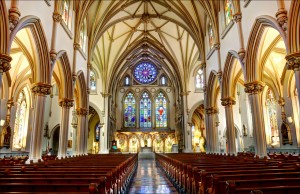 St. Joseph’s Cathedral in Burlington was founded in 1850. It is the first national French parish in New England. Restoration work was carried out in 1920, 1968 and 2001. Its name was given to the Cathedral in October 1999. The spire of St. Joseph’s Cathedral, which ascends to the sky of Burlington, is a landmark for the city’s residents. It is also a fact that the present St. Joseph Cathedral is considered the largest church structure in the State of Vermont.
St. Joseph’s Cathedral in Burlington was founded in 1850. It is the first national French parish in New England. Restoration work was carried out in 1920, 1968 and 2001. Its name was given to the Cathedral in October 1999. The spire of St. Joseph’s Cathedral, which ascends to the sky of Burlington, is a landmark for the city’s residents. It is also a fact that the present St. Joseph Cathedral is considered the largest church structure in the State of Vermont.
Some historical facts to know:
- The construction of the church has become a natural end to the process of migration of Canadians to Vermont and, in particular, to the area of Burlington.
- In 1860 this area became the second port in the world, specializing in lumber, in terms of turnover.
- A small church that was on the beach could no longer cope with the flow of parishioners, and it was decided to expand the church in accordance with the increased requirements of the parish.
Interesting: Not everyone knows that the Cathedral of St. Joseph is officially designated as the Franco-Canadian national parish, which is the most venerable national parish in New England.
Back
Place to visit number 11: The Frog Bridge
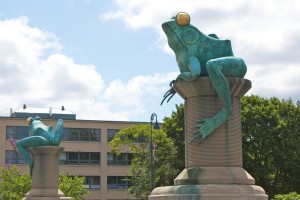 On the bridge at the entrance to the town of Willimantic in Connecticut, there is a very original and at the same time amusing sculpture with an unusual plot – the frog is depicted riding on a thread spool. It is not just a game of the imagination of the creators of sculpture, it is a symbol inspired by a beautiful and at the same time eerie legend.
On the bridge at the entrance to the town of Willimantic in Connecticut, there is a very original and at the same time amusing sculpture with an unusual plot – the frog is depicted riding on a thread spool. It is not just a game of the imagination of the creators of sculpture, it is a symbol inspired by a beautiful and at the same time eerie legend.
The monument appeared due to the following facts:
- First of all, the small town of Willimantic has been famous for many decades as the Thread City – the textile industry here developed almost simultaneously with the growth of the city. To permanently consolidate this fact, the city dwellers with great enthusiasm installed on the bridge at the entrance to the city a small monument of the thread spool, which for many years stood in its original place. At first there was no frog in sight.
- In 1754, late at night, the inhabitants of the city woke up a terrible scream. Taking rifles and sticks, people jumped out onto the streets to protect their native city. However, after standing for about an hour in the cold wind and in complete darkness, they saw nothing. What did the residents of Willimantic see the next morning, going to work? The city square and all the neighborhoods were full of bodies of dead frogs.
What has happened to unfortunate animals so no one has ever learned, but since that time a legend has survived that the frogs fell, saving the city. So there was a new monument, which became a real symbol of the city.
Interesting: This monument is not just a game of the imagination of the creators of sculpture, it is a symbol inspired by a beautiful and at the same time eerie legend.
Back
Place to visit number 12: Paul Revere House
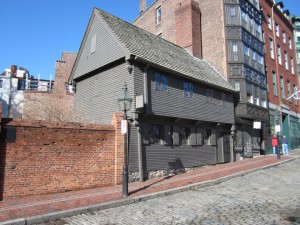 Paul Revere House was built in 1680. It is the oldest building in central Boston. The family of the master Paul Revere lived there, who later became a national hero and an active participant in the American Revolution:
Paul Revere House was built in 1680. It is the oldest building in central Boston. The family of the master Paul Revere lived there, who later became a national hero and an active participant in the American Revolution:
- On the night of April 20, 1775 (the eve of the Battle of Concorde and Lexington), Revere galloped on horseback to positions occupied by the insurgents, and warned them of the approach of British troops, which enabled them to prepare and face the enemy with dignity.
- He also managed to warn the main rioters of Massachusetts Samuel Adams and John Hancock, who at that time were in Lexington. Thanks to this they managed to escape by flight.
In the 19th century, Jewish, Irish and Italian immigrants lived in this house, and in 1902 it was acquired by the grandson of Paul Rivera John P. Reynolds, than saved the house from demolition. He repaired it, restored it, and in 1908 Paul Revere House welcomed visitors as one of the earliest historical museums in the United States.
Interesting: Despite significant changes, still about 90% of the design corresponds to the original. Even some pieces of furniture, which historians suppose, belong to the Revere family, have survived.
Back
A lot of thanks for your entire hard work on this web site. My mum really loves carrying out investigation and it is obvious why. Most people learn all regarding the dynamic method you convey useful tips and hints on this website and as well inspire contribution from other people on the situation and our child has been discovering a lot. Enjoy the rest of the new year. You are always doing a stunning job.